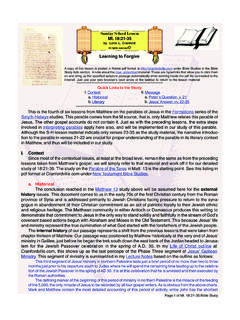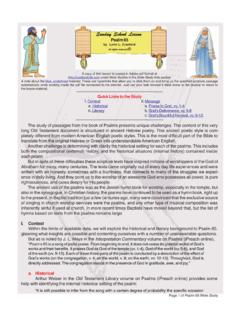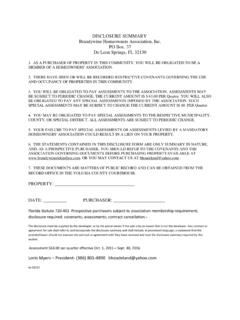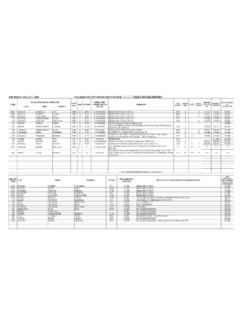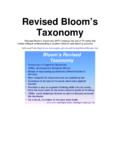Transcription of Sunday School Lesson John 20:19-31 - …
1 Page 1 of john 20:19-31 Bible Study Sunday School Lesson john 20:19-31 by lorin L. Cranford All rights reserved What It Means To Believe A copy of this Lesson is posted in Adobe pdf format at under Bible Studies in the Bible Study Aids section. A note about the blue, underlined material: These are hyperlinks that allow you to click them on and bring up the specified scripture passage automatically while working inside the pdf file connected to the internet. Just use your web browser s back arrow or the taskbar to return to the Lesson material. ** Quick Links to the Study I. Context II. Message a. Historical a. Appearance to the Disciples (1st), vv. 19-23 b. Literary Literary b. Appearance to the Disciples (2nd), vv. 24-29 c. Purpose for Writing, vv. 30-31 ** The Bible study for this week moves from the event of the resurrection itself -- last week s focus -- to a couple of the resurrection appearances of Jesus to his disciples before his ascension back to Heaven.
2 For a listing of the various appearances to the detailed Life of Christ outline at I. Context As is normal, the background information on the gospel of john is important to a more accurate under-standing of our passage. a. Historical Regarding the composition of the fourth gospel, a wide range of viewpoints will be uncovered in modern New Testament scholarship. Regarding the origin of the document, Massey H. Shepherd in the Interpreter s One Volume Commentary on the Bible has a helpful summation: The acceptance of the gospel in the NT canon in the late 2nd - early 3rd cent. was a seal of acceptance of its authorship by john son of Zebedee, one of the 12 apostles of Jesus. Though contested at that time, this official view held the day without serious challenge until recent times; and it is still stoutly defended by many able scholars, Catholic and Protes-tant. Its strongest sup-port is the testimony of Irenaeus, who claimed to have received the tra-dition firsthand, when a youth, from Polycarp.
3 Although modern NT scholarship is not as confident in the tradi-tional view of author-ship, the document s origin is generally viewed to have taken place sometime in the middle 80s to the middle 90s of the first Christian century. Assuming the cor-Page 2 of john 20:19-31 Bible Study rectness of the Johannine connection to this document, the ministry of the Apostle john seems to have been focused in the region of Ephesus in the Roman province of Asia during the second half of the begin-ning Christian century. In this view, the gospel would have been written in that region and most likely addressed to Christians living in the same general area. Alternative views move in the direction of not having an idea about who wrote the gospel and will tend to project a somewhat later date but still originating in the same region. In either case the gospel comes out of a Johannine oriented community of believers and seeks to provide insight about Jesus to members of that community as well as those perhaps attracted to this new religion that would come to be called Christianity.
4 For a helpful summary of the religious views found in the gospel, see Gary M. Burge, john , the Theology of, in the Baker s Evangelical Dictionary of Biblical Theol-ogyBaker s Evangelical Dictionary of Biblical Theol-ogy. b. Literary Regarding the literary setting of 20:19-31 , Gary M. Burge in the Baker s Evangelical Dictionary of Biblical TheologyBaker s Evangelical Dictionary of Biblical Theology has a helpful summary of the literary structure of the fourth gospel: The Fourth Gospel is organized into two principle sections and these are framed by a prologue (1:1-18) and an epilogue (21:1-25), each of which were likely added at some later date either by the Gospel's author or one of his followers. The prologue introduces the incarnation of the preexistent Word and poetically sets the stage for all that is to follow: God discloses his Son in the world of darkness; he is popularly rejected; a select group of followers discover life; and even though the darkness tries, it cannot defeat this Son.
5 The first section is commonly called the Book of Signs (1:19-12:50) in order to describe how Jesus appears within Judaism replacing its institutions (the temple, sacred wells, teachers) and festivals (Passover, Tabernacles). He offers overwhelming messianic gifts that exploit images intrinsic in the Jewish setting in the narrative (wine, wisdom, water, healing, bread, light, life). The final event is the raising of Lazarus which utterly discloses Jesus' identity as well as seals his fate. But even though Jesus experiences hostility among the Jewish leaders in Jerusalem, still he discovers receptivity in Galilee (2:11; 4:45; 7:1; etc.) and at the end of this section, Greeks from Galilee eagerly line up to follow him (12:20-26). The second section is called the Book of Glory (13:1-20:31) because now Jesus takes aside his followers, washes their feet at his final Passover meal (13:1-20), and exhaustively explains to them who he is and what will happen (13:31-17:26).
6 But hinted throughout the Gospel is the notion that the impending cross of Christ will be no tragedy, but a time when his glory will become visible to all (3:13-15; 13:31; 17:1-5). The cross is one more sign given to disclose that Jesus has been sent by the Father and is now returning to him. For john , this cross is voluntary (10:11, 17, 18). Christ is departing, having completed the work he set out to do. But before he goes, he distributes gifts to all among his followers (20:19-29), blessing them one more time. Most scholars think that the earliest ending of the gospel is in 20:30-31 and that chapter 21 is a later addition no doubt from the same Johannine sources that supplied the original Gospel. If it is secondary, it nevertheless has the ring of historicity and the echo of Johannine language. Jesus makes a resurrection appearance and commis-sions his followers in anticipation of his permanent absence. This is perhaps the most commonly held view regarding the thought structure of the gospel of john .
7 And it has more to commend it than most of the alternative viewpoints. My own understanding derived from almost forty years of study of this document is that the role of the Prologue is quite substantial in setting a conceptual foundation for the rest of the document. The basic viewpoint of Jesus as the divine Word (Logos) set forth in 1:1-18 becomes the conceptual filter through which the story of Jesus is told in the remainder of the gospel. For more details see my treatment at under NT Study Aids. This is a major reason for the narrative view of john being so dramatically different than that of the Synoptic Gospels, as each gospel writer tells his own story of Jesus. The particular context of 20:19-31 can be seen more clearly from looking at the Life of Christ outline at : Matthew Mark Luke john VI. Resurrection appearances and ascension 28:1-20 16:1-20 24:1-53 20:1-21:25 (2%) (3%) (5%) (6%) A.
8 The Empty Tomb 28:1-8 16:1-8 24:1-12 20:1-10 Page 3 of john 20:19-31 Bible Study B. The Appearances to His Disciples 28:9-20 16:9-20 24:13-53 20:11-21:25 1. The Bribing of the Soldiers 28:11-15 2. To the Eleven in Galilee 28:16-20 3. To the Two Disciples on the Road to Emmaus ---- (16:12-13) 24:13-35 ---- 4. To the Disciples in Jerusalem ---- (16:14-18) 24:36-49 ---- 5. The Ascension of Jesus ---- (16:19-20) 24:50-53 ---- 6. To Mary Magdalene ---- (16:9-11) ---- 20:11-18 7. To the Disciples in Jerusalem ---- ---- ---- 20:19-23 8. To the Disciples with Thomas present ---- ---- ---- 20:24-29 9. To the Seven Disciples at the Sea of Tiberias ---- ---- ---- 21:1-23 Our passage, 20:19-31 , contains two (#s 7 & 8) of the four resurrection appearances of Jesus to the disciples and to Mary that are found in the fourth gospel.
9 These are unique to this gospel and are not described by any of the other gospel writers. Establishing a clearly defined sequence of the resurrection appearances of Jesus between the three gospels that originally contained accounts is very difficult. The thematic concerns of each gospel writer was more important than reconstructing a chronology of the appearances. We must, therefore, content ourselves to looking at the various accounts in each gospel and gain the insight provided by each. Since there is no overlapping between the accounts, the chronologi-cal issues become less important than they would otherwise be. We can determine, however, that these eight appearances took place over a forty day period between the resurrection and the ascension of Jesus. Luke provides this insight in Acts 1:3 (NRSV): After his suffering he presented himself alive to them by many convincing proofs, appearing to them during forty days and speaking about the kingdom of God.
10 Additionally, the third segment, 20:30-31, contains an expression of the purpose behind the writing of the gospel document itself. II. Message The division of thought inside vv. 19-31 falls naturally into three segments: (1) the appearance of Jesus to the disciples in Jerusalem without Thomas (vv. 19-23); (2) a subsequent appearance to the same group with Thomas present (vv. 24-29); and (3) the purpose behind the writing of the gospel document (vv. 30- 31). a. Appearance to the Disciples (1st), vv. 19-23 The Greek NT 20 19 Ou[sh ou\n ojyiva th / hJmevra/ ejkeivnh/ th / mia / sabbavtwn kai; tw n qurw n kekleismevnwn o{pou h\san oiJ maqhtai; dia; to;n fovbon tw n !Ioudaivwn, h\lqen oJ !Ihsou kai; e[sth eij to; mevson kai; levgei aujtoi , Eijrhvnh uJmi n. 20 20 kai; tou to eijpw;n e[deixen ta; cei ra kai; th;n pleura;n aujtoi . ejcavrhsan ou\n oiJ maqhtai; ijdovnte to;n kuvrion. 20 21 ei\pen ou\n aujtoi oJ NRSV 19 When it was evening on that day, the first day of the week, and the doors of the house where the disciples had met were locked for fear of the Jews, Jesus came and stood among them and said, "Peace be with you.]]]}
